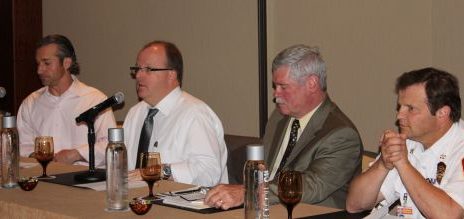A study released this week by the City of Boston shows the risk of a hazardous cargo truck accident within Boston’s city streets is 819%, or more than 8x higher, than using an “alternative route” of highways (I-93/I-95/Route 128) around the city. Shown below is the summary slide from the study, dated June 22, 2010.
On May 17, 2010, a preemptive federal ruling ended the city’s de facto daytime ban of haz-mat trucks in Boston, routing the trucks on Commercial Street through the North End/Waterfront neighborhood. Pleas from local officials resulted in a 45-day extension from the Federal Motor Carrier Safety Administration (FMCSA) that will expire on July 1st. Over the last several weeks, the North End/Waterfront community has received an education on the way that hazardous cargo is routed on our city streets and highways. In support of its de facto daytime ban, City officials have presented a preliminary safety study done by Norbridge, a consulting company in Concord, Massachusetts. (Click here to view the entire Norbridge presentation in pdf form.)
For its part, the trucking industry has provided documentation showing the City and State ignored federal regulations by imposing the de facto ban, citing guidelines that require Federal approval for routing changes. For those interested, the various communications between the authorities and the trucking industry can be found here in the official rulemaking “docket folder.” (At the website, check Public Submissions and go to last page to see the most recent letters.)
What happens on July 1st?
After a meeting last week between public officials and the trucking industry, it appears that a compromise has been worked out for when the FMSCA’s extension expires on July 1st. It is still unclear exactly what will happen, but the compromise could allow for limited cut-throughs using Cross Street while the City of Boston finishes the safety study required by Federal regulations. The safety study would consider alternative city streets, such as Congress St. or Mass Ave. in addition to the North End’s Commercial and Cross Street routes. Currently, the night time route uses Cross Street through the city, although the night traffic is a fraction of what would be experienced during daytime hours. Notably, local deliveries are always allowed in the city. The debate centers on “cut-through” hazardous cargo traffic, mostly between the Everett gas terminals and South Shore areas.
The Norbridge report also summarizes the history of hazardous cargo routing in Boston from 1994 and the current legal challenge from the trucking industry. This summary slide is shown below.
As part of the process to meet Federal guidelines, the City of Boston has contracted a $250,000 detailed study by Battelle, a specialist consulting firm. Battelle is currently collecting data with a report to be given to the City by late August. More information on Battelle can be found at http://www.battelle.org. The schedule of Battelle’s study is shown in the slide below.
Click here to view Battelle’s entire presentation of its study scope (large pdf).
Local HazMatters Taskforce
In the meantime, a local effort continues to stop the haz-mat trucks from using the North End/Waterfront streets. More information from the local Haz-Mat Taskforce can be found at: www.hazmatters.eboard.com.
June 27th Gas Tanker Rollover Accident on I-95
Coincident with the aforementioned debate, a tanker truck flipped over on I-95 this morning, near Foxboro, spilling much of its 11,000 gallons of jet fuel. The driver sustained injuries and I-95 was temporarily closed during the cleanup. This is the type of accident that local North End/Waterfront residents fear. Such an incident combined with the dense population and pedestrian traffic could have caused several fatalities and severe environmental damage. A news video clip is below.
During the week in May 2010 when the Haz-Mat trucks were permitted on Commercial Street, neighbors reported several violations, including the one below caught on video.
View all posts on the hazardous cargo situation in the North End/Waterfront.







These trucks should NOT drive down Cross Street – people live there. They should go around the city.